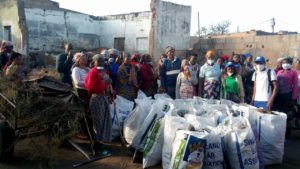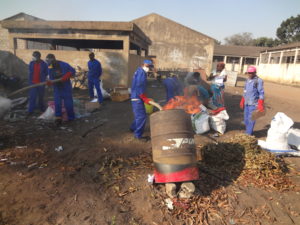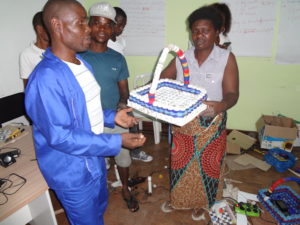As part of the implementation of the project “Strengthening Dialogue between Civil Society and the Maputo Municipal Council in Solid Waste Management”, by the French Embassy through Innovative Civil Society and Coalition of Actors (PISCCA) projects, the Mozambican Association of Recycling developed in July the following activity:
Consolidation of training on Maputo City Council Master Plan
This training benefited 15 members of three primary solid waste micro-enterprises. Twenty-eight proposals and indicators were formulated to achieve the objectives outlined in the new Master Plan that will be in force over the next 5 years. As a result of the exercise performed (in flipchart), contributions were presented for the components (1) Collection and Transportation, (2) Reduction and Reuse and (3) Education and Awareness.
The consolidation resulted in the formulation of contributions in response to the indicators shown below:
| Pickup & Shippin | |
| Contributions formulated | Indicator |
| 1. Collection of waste in outbreaks | No. of outbreaks eliminated |
| 2. Collect door to door for container using tchova | No. Of times a week tchova enters neighborhoods to collect |
| 3.Increased field clearance for collections | No. Of new augmented roofs |
| 4.Improvement of access roads | No. Of improved access roads (eg hole closures, water pools that make it difficult for tovaks to circulate on the ground) |
| 5.Report the municipal authorities if the container is full (unable to deposit more waste) or burning | No. Of reported cases |
| 6. Properly collect primary health status of neighborhoods | |
| 7. Interpretation of the Master Plan | No. of members trained on the Master Plan |
| 8. Appropriate material for collection and transport Use of PPE – Personal Protective | Equipment by members for ex activities. mask, gloves, uniforms, boots, etc. |
| 9. Increase in staff (collection operators) | No of new collection operators contracted |
| 10. Set targets for compliance with the collection plan designed as well as oversee the same weekly activity plan for each neighborhood. | |
| 11. Cleaning around container | No. Of weekly cleaning |
| 12. Disposal of Informal Dumpsters or Scattered Trash | No. Of Clean-up Days Taken Together with the Community |
| Reduction and Reuse | |
| Contributions formulated | Indicators |
| 1. Selection of recyclable material during collections | Amount of recyclable material collected |
| 2. Reuse of waste for production of handicrafts (poufs, baskets, bottle decoration, etc.) | Amount of recycled material reused |
| 3.Production of soap from processing used cooking oil | Amount of recycled oil |
| 4.Charcoal production from organic waste processing | Amount of recycled organic waste |
| 5. Sell recyclable waste (recovery) | Quantity of recycled waste sold |
| 6.Training staff on selection and utilization of MSW | No. of trained members |
| 7.Draw programs that promote reduction and reuse | |
| Education and Awareness | |
| Contributions formulated | Indicators |
| 1.Inform the community about the existence of ecopoints and mobilize to use | No. Of sensitized families |
| 2. Door-to-door campaigns
|
No. Of campaigns conducted in the neighborhood |
| 3. Mobilizing residents to participate in neighborhood clean-up journeys | No. Of meetings with local structures and residents |
| 4. Sensitization of residents in each block | No. Of blocks covered |
| 5.Coordination of cleaning activities with market vendors | No. of shares in market cleanups |
| 6. Sensitization of market vendors to deposit waste at designated locations | No. Of awareness of market vendors |
| 7.Training operators who will talk to the community (awareness-raising subject) | No. of trained operators |
| 8. Take a SWOT analysis of the neighborhood | Identify Straights, Weaknesses, Opportunities and Threats |
| 9. Identify the challenges encountered | Raising awareness to overcome them |
The second and third training sessions on coal production took place at Xipamanine Camp, which aimed to obtain coal dust. Trainees organized dry organic waste (leaves, coconut shells, grass, paper, cardboard, etc.) that were used to feed the drum ovens at the time of combustion.
Members of three waste collection associations benefited from two training sessions on craftwork production by reusing PET caps and caps to produce buckets and baskets.
Together with the associations ASSCODECHA, KUTENGA and MAKTEL BACISSA we organized three clean-up days covering the neighborhoods of Chamanculo C, Hulene A and Maxaquene C. 108 local residents including block chiefs and members of the area clean-up associations were involved in this activity. considered critical for the amount of improperly disposed garbage, and 69 50kg raffia bags of various waste were collected (plastic, paper, cardboard, PET bottles, glass, disposable garbage, leaves and tree branches, etc.).
Finally, with the support of the Municipal Health and Graveyards Directorate (DMSC) of the Maputo Municipal Council, we conducted training on environmental awareness techniques for 15 primary solid waste collection operators. The DMSC These shared experiences in the environmental awareness of the residents, and stressed the need for involvement of local structures (neighborhood secretaries and block chiefs) that facilitate meetings or meetings with local residents.



